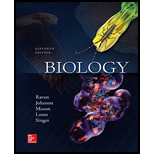
Biology
11th Edition
ISBN: 9781259188138
Author: Peter H Raven, George B Johnson Professor, Kenneth A. Mason Dr. Ph.D., Jonathan Losos Dr., Susan Singer
Publisher: McGraw-Hill Education
expand_more
expand_more
format_list_bulleted
Concept explainers
Question
Chapter 3, Problem 1S
Summary Introduction
To determine:
“How the four molecules are different from each other and also relate the structure to its function”.
Introduction:
There are four different
Expert Solution & Answer
Want to see the full answer?
Check out a sample textbook solution
Students have asked these similar questions
How do the structures of biological macromolecules such as carbohydrates, lipids, nucleic acid, and proteins determine their properties and functions?
How do proteins differ from other macromolecules?
What are the different major macromolecules? How are they interrelated to each other? Is there a more superior macromolecule?
Chapter 3 Solutions
Biology
Ch. 3 - Prob. 1UCh. 3 - Why are carbohydrates important molecules for...Ch. 3 - Plant cells store energy in the form of ______,...Ch. 3 - Prob. 4UCh. 3 - A molecule of DNA or RNA is a polymer of a....Ch. 3 - Prob. 6UCh. 3 - What monomers make up a protein? a....Ch. 3 - A triglyceride is a form of _______ composed of...Ch. 3 - You can use starch or glycogen as an energy...Ch. 3 - Which of the following is NOT a difference between...
Ch. 3 - Prob. 3ACh. 3 - A mutation that alters a single amino acid within...Ch. 3 - Two different proteins have the same domain in...Ch. 3 - What aspect of triglyceride structure accounts for...Ch. 3 - The spontaneous formation of a lipid bilayer in an...Ch. 3 - Prob. 1SCh. 3 - Hydrogen bonds and hydrophobic interactions each...Ch. 3 - Prob. 3S
Knowledge Booster
Learn more about
Need a deep-dive on the concept behind this application? Look no further. Learn more about this topic, biology and related others by exploring similar questions and additional content below.Similar questions
- Describe the four levels of protein structure. How do a proteins side groups influence its interactions with other substances? What happens when a protein is denatured?arrow_forwardHow does RNA differ from DNA?arrow_forwardWhat are the three most common lipids in living organisms? How do their structures differ?arrow_forward
arrow_back_ios
arrow_forward_ios
Recommended textbooks for you
 Biology: The Dynamic Science (MindTap Course List)BiologyISBN:9781305389892Author:Peter J. Russell, Paul E. Hertz, Beverly McMillanPublisher:Cengage Learning
Biology: The Dynamic Science (MindTap Course List)BiologyISBN:9781305389892Author:Peter J. Russell, Paul E. Hertz, Beverly McMillanPublisher:Cengage Learning Human Biology (MindTap Course List)BiologyISBN:9781305112100Author:Cecie Starr, Beverly McMillanPublisher:Cengage Learning
Human Biology (MindTap Course List)BiologyISBN:9781305112100Author:Cecie Starr, Beverly McMillanPublisher:Cengage Learning

Biology: The Dynamic Science (MindTap Course List)
Biology
ISBN:9781305389892
Author:Peter J. Russell, Paul E. Hertz, Beverly McMillan
Publisher:Cengage Learning

Human Biology (MindTap Course List)
Biology
ISBN:9781305112100
Author:Cecie Starr, Beverly McMillan
Publisher:Cengage Learning